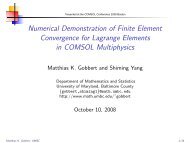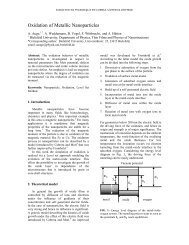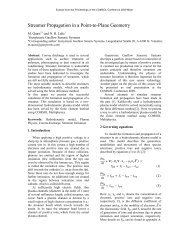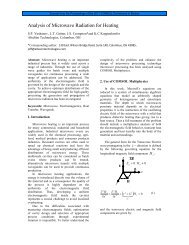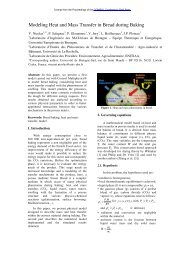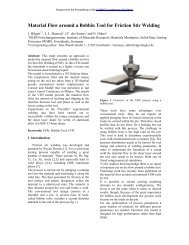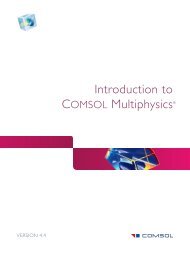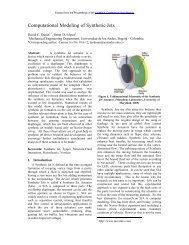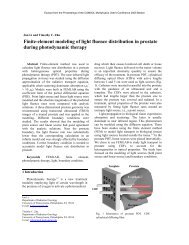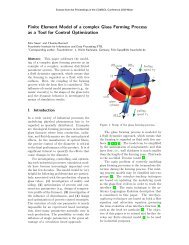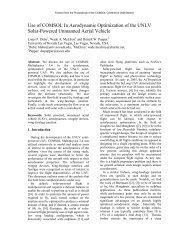Simulation of heat and momentum flow in a quartz mercury ... - Comsol
Simulation of heat and momentum flow in a quartz mercury ... - Comsol
Simulation of heat and momentum flow in a quartz mercury ... - Comsol
- No tags were found...
Create successful ePaper yourself
Turn your PDF publications into a flip-book with our unique Google optimized e-Paper software.
Excerpt from the Proceed<strong>in</strong>gs <strong>of</strong> the COMSOL Multiphysics User's Conference 2005 Bostonr r∇ ∇ =( σ φ) 0,(6)with a coupl<strong>in</strong>g to the temperature through theelectrical conductivity σ . The boundary conditionson φ are no-flux along the <strong>in</strong>ner arc-tube surface <strong>and</strong>lamp axis, <strong>and</strong> constant values at the electrodes.These electrode values impose a voltage differenceacross the lamp which drives the Elenbaas-Hellerequation through the <strong>heat</strong>-source term <strong>of</strong> Eq. (4).Mathematically, the electrode values <strong>of</strong> φ aredeterm<strong>in</strong>ed by allow<strong>in</strong>g them to float to whatevervalue enables the satisfaction <strong>of</strong> the global <strong>in</strong>tergralconstra<strong>in</strong>tr 2P= σ ∇φdV,∫Lamp(7)where P = 175 W is the specified power <strong>of</strong> thelamp.Equations (1)-(6) are recast <strong>in</strong> a form with alldimensionless variables, <strong>and</strong> then implemented <strong>in</strong>FEMLAB us<strong>in</strong>g its general form. This dimensionlessformulation is straightforward except for thetreatment <strong>of</strong> the potential φ . Here a dimensionlessvariable φ % is def<strong>in</strong>ed by scal<strong>in</strong>g the potential with itsunknown value at the electrodes. This way, theelectrode boundary conditions on the dimensionless% . Then% φ are the simple Dirichlet condition φ =± 1the <strong>in</strong>tegral constra<strong>in</strong>t <strong>of</strong> Eq. (7) is imposed us<strong>in</strong>g the<strong>in</strong>tegration coupl<strong>in</strong>g variable feature, <strong>and</strong> is then usedto determ<strong>in</strong>e the dimensionless parameter thatprecedes the <strong>heat</strong>-source term <strong>in</strong> the dimensionlessversion <strong>of</strong> Eqs. (4). The dimensionless system coded<strong>in</strong>to FEMLAB is a full mathematical equivalent toEqs. (1) - (7).3 Convergence <strong>and</strong> model outputBecause <strong>of</strong> the coupl<strong>in</strong>g <strong>and</strong> strong temperaturedependence <strong>of</strong> the electrical conductivity σ <strong>and</strong> theradiation qrad, some care is required <strong>in</strong> the <strong>in</strong>itialconditions to obta<strong>in</strong> convergence. Convergence isobta<strong>in</strong>ed by build<strong>in</strong>g up the computation <strong>in</strong> 3 stages,each comput<strong>in</strong>g a larger portion <strong>of</strong> the fully-coupledproblem. All <strong>of</strong> this is programmed <strong>in</strong> a MATLAB.m file. The <strong>in</strong>itial fields are a quiescent velocityfield, a gas temperature pr<strong>of</strong>ile that is parabolic <strong>in</strong> theradial direction, <strong>and</strong> a potential pr<strong>of</strong>ile that is l<strong>in</strong>ear<strong>in</strong> the axial direction. The first stage is to solve Eq.(6) (current cont<strong>in</strong>uity) for the potential φ with allother variables held fixed. In the second stage, theoutput <strong>of</strong> the first stage is fed <strong>in</strong>to a coupled,unsteady simulation <strong>of</strong> Eqs. (4) <strong>and</strong> (6) together, withthe <strong>momentum</strong> <strong>and</strong> mass cont<strong>in</strong>uity equations stillheld fixed with zero velocity field. This pair <strong>of</strong>equations is run until the solution for temperature T<strong>and</strong> potential φ is approximately steady. The thirdstage is to solve the full coupled set <strong>of</strong> equations <strong>in</strong> asteady simulation, start<strong>in</strong>g from the output <strong>of</strong> thesecond stage. For this stage, the model must beconverted from the general form to the weak form, toassure that FEMLAB <strong>in</strong>cludes Eq. (7) when itcomputes the Jacobian. This nonlocal Jacobianmakes the simulation rather computationally<strong>in</strong>tensive. Nevertheless, the simulation with all 3stages reaches a fully-coupled steady solution <strong>in</strong> justunder 2 m<strong>in</strong>tues.The primary output <strong>of</strong> the simulation is atemperature <strong>and</strong> velocity map, as shown <strong>in</strong> Figure 3.Figure 3: Temperature pr<strong>of</strong>ile with velocityvectors. Spatial dimensions are normalized by thearc-tube <strong>in</strong>ner radius.The radial temperature gradient gives rise to a densitygradient, which makes the gas <strong>in</strong> the center muchlighter than the gas near the walls. This creates abuoyancy force which makes the gas rise <strong>in</strong> the center<strong>and</strong> fall along the arc-tube wall.Halfway between the electrodes, the temperature<strong>and</strong> velocity pr<strong>of</strong>iles are shown <strong>in</strong> Figure 4 <strong>and</strong>Figure 5 respectively.



